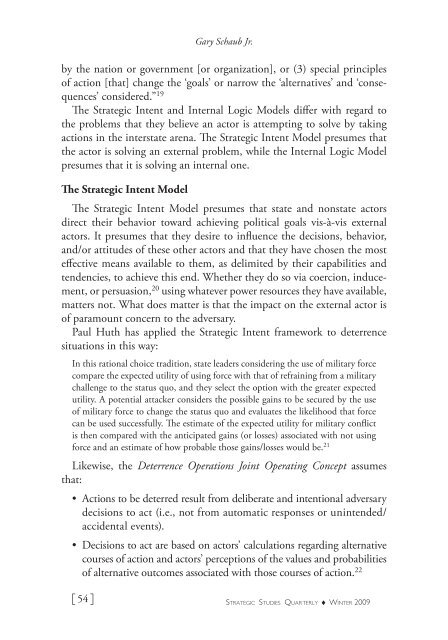When Is Deterrence Necessary? Gauging Adversary Intent
When Is Deterrence Necessary? Gauging Adversary Intent
When Is Deterrence Necessary? Gauging Adversary Intent
You also want an ePaper? Increase the reach of your titles
YUMPU automatically turns print PDFs into web optimized ePapers that Google loves.
Gary Schaub Jr.<br />
by the nation or government [or organization], or (3) special principles<br />
of action [that] change the ‘goals’ or narrow the ‘alternatives’ and ‘consequences’<br />
considered.” 19<br />
The Strategic <strong>Intent</strong> and Internal Logic Models differ with regard to<br />
the problems that they believe an actor is attempting to solve by taking<br />
actions in the interstate arena. The Strategic <strong>Intent</strong> Model presumes that<br />
the actor is solving an external problem, while the Internal Logic Model<br />
presumes that it is solving an internal one.<br />
The Strategic <strong>Intent</strong> Model<br />
The Strategic <strong>Intent</strong> Model presumes that state and nonstate actors<br />
direct their behavior toward achieving political goals vis-à-vis external<br />
actors. It presumes that they desire to influence the decisions, behavior,<br />
and/or attitudes of these other actors and that they have chosen the most<br />
effective means available to them, as delimited by their capabilities and<br />
tendencies, to achieve this end. Whether they do so via coercion, inducement,<br />
or persuasion, 20 using whatever power resources they have available,<br />
matters not. What does matter is that the impact on the external actor is<br />
of paramount concern to the adversary.<br />
Paul Huth has applied the Strategic <strong>Intent</strong> framework to deterrence<br />
situations in this way:<br />
In this rational choice tradition, state leaders considering the use of military force<br />
compare the expected utility of using force with that of refraining from a military<br />
challenge to the status quo, and they select the option with the greater expected<br />
utility. A potential attacker considers the possible gains to be secured by the use<br />
of military force to change the status quo and evaluates the likelihood that force<br />
can be used successfully. The estimate of the expected utility for military conflict<br />
is then compared with the anticipated gains (or losses) associated with not using<br />
force and an estimate of how probable those gains/losses would be. 21<br />
Likewise, the <strong>Deterrence</strong> Operations Joint Operating Concept assumes<br />
that:<br />
• Actions to be deterred result from deliberate and intentional adversary<br />
decisions to act (i.e., not from automatic responses or unintended/<br />
accidental events).<br />
• Decisions to act are based on actors’ calculations regarding alternative<br />
courses of action and actors’ perceptions of the values and probabilities<br />
of alternative outcomes associated with those courses of action. 22<br />
[ 54 ]<br />
Strategic Studies Quarterly ♦ Winter 2009
















